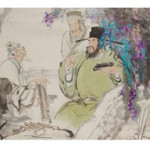The Tubo people were the ancestors of the Tibetan people. They appeared on the Qinghai-Tibet Plateau at a very early period. They were farmers and herders. In the early seventh century, Songtsen Gampo united the various Tubo tribes, and made Luoxie (today’s Lhasa) the capital of the Tubo kingdom.
Songtsen Gampo admired the culture of the Tang Dynasty, and was eager to form an alliance with that powerful empire. In 641, Emperor Taizong sent Princess Wencheng to him as his bride.
The Tubo people used to live in tents. It is said that a gorgeous palace was built specially for her, which was the predecessor of today’s Potala Palace.
Princess Wencheng took with her to Tubo medicines, books on science and technology, grain and vegetable seeds, and exquisite handicrafts of the Tang Dynasty. In addition, people who were proficient in raising silkworms, making wine and paper, and weaving and embroidering accompanied her, to teach these arts to the people of Tibet. Princess Wencheng was an ardent believer in Buddhism. It is said that the location of the Jokhang Temple was chosen by her.
Princess Wencheng lived in Tubo for 40 years, making great contributions to the friendship between the Han and Tibetan peoples. She is still remembered and loved by the Tibetans. Statues of Princess Wencheng are preserved in the Jokhang Temple and Potala Palace. There are many beautiful legends told about Princess Wencheng among the Tibetan people.











发布产品咨询